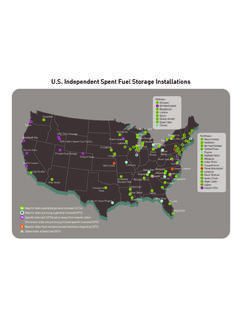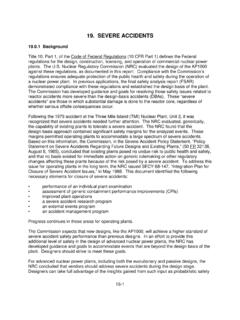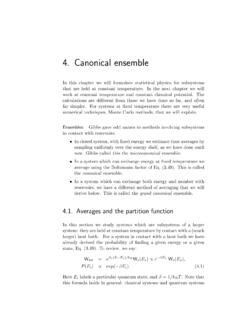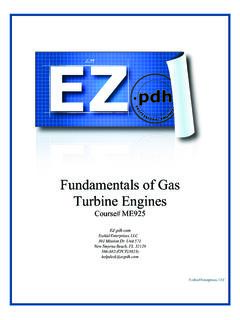Transcription of Interaction of Photons With Matter
1 Interaction of Photons with Matter17/5/2011 General Stuff2 Objectives To review three principal interactions of Photons with Matter . To examine the factors affecting the 3gprobability of photon interactions. To introduce the linear and mass attenuation coefficients as useful measures of the probability of Understanding how radiation interacts with Matter is essential to understanding:4 How instruments detect radiation How dose is delivered to tissue How to design an effective shieldProperties of Photons A photon is a packet of electromagnetic It has no mass, no charge, and travels in a straight line at the speed of of Photons (cont'd)This discussion is limited to Photons with enough energy to ionize Matter : 7 X-rays:characteristic x-raysbremsstrahlung gamma rays annihilation radiation (511 keV) photon Interactions Photons interact differently in Matter than charged particles because Photons have no electrical In contrast to charged particles, Photons do not continuously lose energy when they travel through Interactions (cont'd) When Photons interact, they transfer energy to charged particles (usually electrons) and the charged particles ithii d9give up their energy via secondary interactions (mostly ionization).
2 The Interaction of Photons with Matter is probabilistic, while the Interaction of charged particles is certain.+++++-------alphaBetae-+-10 Possible GammaInteractions Gamma 11e-Gamma ?12 photon Interactions (cont'd) The probability of a photon interacting depends upon:13 The photon energy The atomic number and density of the material (electron density of the absorbing Matter ). photon Interactions (cont'd) The three principal types of photon interactions are:Ph tl t iff t14 Photoelectric effect Compton scattering (incoherent scattering) Pair productionPhoton Interactions (cont'd) There are a number of less important mechanisms by which Photons interact with Matter . The most important of the unimportant photon interactions are:15 Rayleigh scattering (coherent scattering) Thomson scattering (coherent scattering) Photonuclear reactionsPhotoelectric Interaction16 In the photoelectric (PE) Interaction , the photon is absorbed by an inner shell ( , K shell) electron of an Interaction17 All the photon energy is transferred to the electron so that the photon disappears.
3 The electron is ejected from the atom. This leaves a vacancy in the shell that the electron originally Interaction Some of the photon s energy is used to overcome the binding energye-18the binding energy of the electron The rest of its energy is given to the electron as kinetic energye-e-e-PEPhotoelectric Interaction The vacancy created in the electron shell is then filled by an electron falling from a higher energy shell19ggy When this happens, either a characteristic x-ray or an auger electron is emittede-20e-e-e-ee-e-21e-e-e-ee-e-22e-e -e-ee-e-23e-e-e-ee-e-24e-e-e-ee-e-25e-e- e-ee-e-26e-e-e-ee-e-27e-e-e-ee-e-e-28e-e -e-ee-e-29e-e-e-eCharacteristic x-ray30e-e-e-e-31e-e-e-e-Photoelectric Interaction PE interactions are desirable in shields for Photons since the Photons are completely absorbed. 32py On the other hand, PE interactions are not desirable from the standpoint of absorbed dose to human Interaction The PE Interaction is most probable for: Low energy Photons (as long as the33 Low energy Photons (as long as the photon energy exceeds the electron s binding energy) High atomic number and high density materials ( , high electron density)Photoelectric Interaction Lead is widely used for shielding gamma rays and x-rays because it has a high atomic number (Z = 82) and it is Tungsten has a lower atomic number (Z = 74) but is a better shield because it has a much higher density (18-19 g/cm3) than lead (11 g/cm3) Uranium can be an even better shield.)
4 Its atomic number is 92 and its density is 18 g/cm3 Compton Scattering35 Compton Scattering In Compton scattering, a photon transfers a portion of its energy to a loosely bound outer shell electron of an atom (the binding energy fthl tiiddli ibl )36of the electron is considered negligible) The photon loses energy and changes direction. This is known as incoherent ( E(237e-e-e-e-e- The following equation is used to calculate the energy of the scattered photon (E ()Compton Scattering38 The following equation is then used to calculate the energy of the scattered electron (Ee)Compton Scattering39 The division of energy between the electron and scattered photon depends on the angle of scatter (2)Compton Scattering40 The photon loses the least amount of its energy when 2is small The photon loses the largest amount of its energy when 2is 180 degrees For example, lets calculate the energy of the scattered photon (E () when a 1 MeV photon (E() scatters at an angle of:Compton Scattering41p(()g 10 180 E( (?)))))))
5 E((1 MeV)2(10, 180)42e-e-e-e-e-Compton Scattering43E = 1 MeV, and 2= 10 and 180 10 Degree Scattering Angle44180 Degree Scattering Angle45 Bonus calculation! We will now calculate the energy of 2 MeV Photons scattered at 180 46 In most situations, the energy of gamma rays scattered at 180 is close to 200 Scattering47 As the energy of the original Photons decrease, the energy of the scattered Photons decrease. Compton scattering occurs at all photon energies and in all Scattering48 The potential for Compton scattering is always present. It is usually the most probable type of Interaction The Photons are scattered in all directions by the scattering object. Compton Scattering49 The more energetic the incident photon , the more forward the scatter (smaller 2) Lower energy Photons are more likely to scatter at an angle of 90 or higher. The photon loses the greatest amount of energy when 2= 180.)
6 Compton Scattering50 The scattered electron has the greatest amount of energy when 2= 180 .e-51e-e-e-ee-e-52E (1 MeV)e-e-e-ee-e-53E (1 MeV)e-e-e-ee-e-180 degrees54eE ( )( MeV)e-e-e-e-e-E 55eE ( )( MeV)e-e-e-e-56e-e-e-e- In some radiation safety applications the exposure to Compton scattered Photons can be a significant source of exposure, Compton Scattering57gp,for example, to medical personnel present during radiological procedures. In most applications Compton scattering is undesirable, , Gamma spectroscopyCompton Scattering58 Gamma spectroscopy Diagnostic x-ray imaging However, the absorbed dose to a tumor from Photons in radiation therapy is actually delivered by the Compton scattered Production59 Pair Production In pair production, a photon interacts with the electric field of the nucleus of an The photon completely disappears while an electron and a positron are Productione- Since the electron and positron each have an energy equivalence of 511 keV, the incoming photon must have an energy of at least 1022 keV for pair production to take place.
7 61nucleusPPe+ Any additional photon energy above 1022 keV is given to the positron and the electron as kinetic energy. The kinetic energy of the electron and the positron tilthPair Production62are not necessarily the same. PP is most likely to occur with relatively high photon energies and high atomic number materials (larger nuclei). The electron and positron will give up their kinetic energy via ionization, excitation and/or bremsstrahlung. Ultimately the positron will annihilate itself and anPair Production63 Ultimately, the positron will annihilate itself and an electron, most likely after it has given up all of its kinetic energy. The result is the production of two 511 keV annihilation Photons . If the positron comes to rest before its annihilation (the most probable case), the two Photons will be emitted 180 degrees from each +e-68nucleuse+e+69e-Innocent bystandere+70e-Innocent bystandere+71e-Innocent bystander511 keV511 keV72511 keV511 keV In shielding, spectroscopy, or dosimetry applications, the two 511 keV Photons created after pair production must Pair Production73ppalways be considered.
8 A fanciful thought : The positron can be thought of as the electron moving backward in time!+511 Pair Production74backward in time!e-e+TIME511 The Most Important of the Unimportant photon 75 Interactions with Matter Raleigh scattering is a type of coherent scattering whereas Compton scattering is incoherent. with coherent scattering, the photon changes Raleigh Scattering76direction but does not lose energy. Its wavelength is unaffected. Because it can be explained in terms of a wave particle Interaction , it is sometimes referred to as classical scattering. The photon is the wave and the electron is the particle. The photon is viewed as electric and magnetic waves oscillating in two planes at right angles to each other. The intersection of the two planes is defined by the trajectory of the photon . Raleigh Scattering77 photon TrajectoryMagnetic vector of electromagnetic waveElectric vector of electromagnetic wave The electric field of the passing photon causes the electrons of an atom to oscillate.
9 These vibrating electrons emit their own electromagnetic radiation and return to their original undisturbed state. The electromagnetic emissions of the atom s electrons to combine to produce a photon (electromagnetic wave) that leaves in a direction differentRaleigh Scattering78(electromagnetic wave) that leaves in a direction different from that of the incident photon . Raleigh scattering is most important when the photon energy is low and the atomic number is high. In such a case, the binding energy of the outer electrons is high compared to the photon energy - this limits the probability of Compton scattering. In the case of lead, Raleigh scattering can be more probable than Compton scattering at energies up to 100 keV or so. In water, this is true up to about 10 keV. At these low energies, the photoelectric effect is far more probable than either type of Scattering79 The scattering angle is quite small.
10 The net effect of coherent scattering (in shielding, x-ray imaging, etc.) is essentially the same as Compton scattering at shallow angles where little energy is lost by the photon . Thomson scattering is another type of coherent scattering. It is of even less interest than Raleigh scattering. In Thomson scattering, only a single free electron is involved rather than all the electrons of the atom as was the case with Raleigh scatteringThomson Scattering80the case with Raleigh scattering. Once again, the electromagnetic wave of the photon causes the vibration of the electron. Note, this is not a case of excitation where the electron is moved to a higher energy level. The original photon disappears and a new photon of the same energy is emitted in a different direction. In photonuclear reactions, the photon is absorbed by the nucleus of the atom and a nuclear particle (neutron, proton, alpha) is ejected.

















